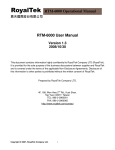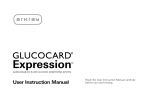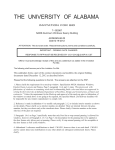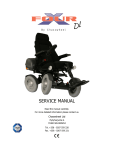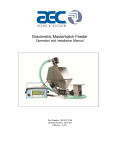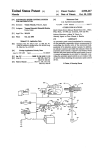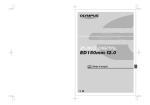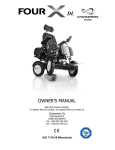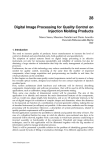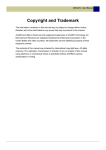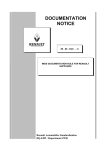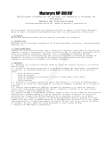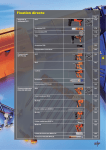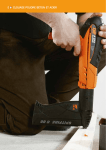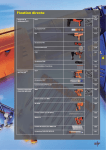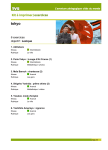Download The User Guide - Online SRM welcome
Transcript
IISRP Synthetic Rubber Manual Online User Guide-8/3/2015 Table of Contents Section Page I. Log In II. Menus & Profile III. Show, Edit, Add Show Ribbon Buttons Search View Detail Add Edit Delete 1 2 8 9 10 10 11 14 17 IV. Drop Down Box Contents a. Carbon Black b. Catalyst Systems c. Coagulation d. Emulsifier e. Ethylene Content f. Product Form h. Third Monomer i. Oil Type j. Product Stain k. Unsaturation l. BR Numbering 24 24 25 25 25 26 26 26 26 26 IV. Administrators 28 1 IISRP Synthetic Rubber Manual Online User Guide-8/3/2015 I. Log In: You must log in to the application. There are three categories of users. a. IISRP members: All IISRP members can SHOW (see the information) b. TOC (Technical Operating Committee) members: TOC members can SHOW and EDIT & ADD records c. ADMINISTRATORS: There are additional functions for ADMIN such as adding users & producers Figure 1 2 IISRP Synthetic Rubber Manual Online User Guide-8/3/2015 II. Menus & Profile: After you log in you will have access to the menus which are multi level. You will also first be shown your profile. TOC & ADMIN users can update their user id and password…Member users cannot edit this. NOTE: For IISRP members the password will be changed as the membership changes…you will need to get the current password from: iisrp.com -> Members homepage You will also have a link to the application from there. The Profile: My Company Figure 2 To Edit your profile click on the Edit can make your changes. button. You will be taken to the edit screen where you 3 IISRP Synthetic Rubber Manual Online User Guide-8/3/2015 Figure 3 After you make your changes hit the SAVE button your changes will be displayed. and you will return to your profile where The Menu: The application menus are multi level. MY COMPANY: TOC members can edit the company information associated with their records. Currently you can only edit from the grid (figure 4.) If you need to add a new company you must request this from an Administrator. (Sue Flynn: [email protected] or Jim McGraw [email protected]) 4 IISRP Synthetic Rubber Manual Online User Guide-8/3/2015 Figure 4 After you make your changes hit the: Save changes. button and this will save your THE MENUS: The application menus are multi-level: Major SR: has BR, CR, EPM/EPDM, ESBR, IR, IIR, NBR, SBC, SSBR. Underneath these are the categories of the different types which are basically the tables in the books (See figure 5 for breakout & figure 6 for an example). 5 IISRP Synthetic Rubber Manual Online User Guide-8/3/2015 Figure 5 Top Level Menu Name ESBR ESBR ESBR ESBR ESBR ESBR SSBR SSBR BR BR BR IR IIR IIR IIR EPM/EPDM EPM/EPDM EPM/EPDM EPM/EPDM NBR NBR NBR NBR NBR NBR NBR NBR CR SBC SBC SBC Special Special Special Special Special Special In 2nd Level Menu Hot Non‐Pigmntd Cold Non‐Pigmntd Cold Blk Mstrbtch Cold Oil Mstrbtch 17 Oil Blk Mstrbtch 18 H‐Styrenic Resin SSBR SSBR (Isoprene) BR/PBR Dry Liquid IR Butyl BIIR/CIIR Polyisobutylene Ethylene Propylene Oil Low Molecular Silicone Dry Particulate Crumb Blk Mstrbtch NBR‐PVC Liquid Hi‐Sat/Hrdgntd Carboxylated CR YSBR(SBS) SIS SEBS/SEPS Therm. Plystr Plymde Ethy./Vinyl Acetate Silicone Polysulfide Polyeurethane Ethyl‐Acrylic SRM Book Table No. 3.1 3.2 3.3 Full Rubber Name Emulsion Styrene Butadiene Hot Non‐Pigmented Emulsion Styrene‐Butadiene Cold Non‐Pigmented Emulsion Styrene‐Butadiene Cold Black Masterbatch 3.4 Emulsion Styrene‐Butadiene Cold Oil Masterbatch (17xx) 3.6 4.1 4.2 5.1 5.2 5.3 6 7.1 7.2 7.3 Emulsion Styrene‐Butadiene Cold Oil Black Masterbatch(18xx) Emulsion High Styrenics HSR (Resin) Solution Styrene‐Butadiene Dry Solution Styrene‐Isoprene Buradiene Dry PolyButadiene or Solution‐Butadiene (BR/PBR) Emulsion Polybutadiene Dry Liquid Polybutadiene Polyisoprene Butyl Halogenated Butyl (BIIR/CIIR) Polyisobutylene 8.1 Ethylene Propylene Rubber 8.2 8.3 8.4 9.1 9.2 9.3 9.4 9.5 9.6 9.7 9.8 10.1 11.1 11.2 11.3 Oil Extended Low Molecular Weight Silicone Modified Nitrile Dry Particulate Crumb Black Masterbatch (particulate) Nitrile/PVC Blend(NBR‐PVC) Liquid Highly Saturate or Hydrogenated Acylonitrile Carboxylated Polychloroprene Dry Block Copolymers of Styrene & Butadiene ‐YSBR(SBS) Block Copolymers of Styrene and Isoprene YSIR(SIS) Hydogenated Block Copolymers (SEBS/SEPS) 12.1 Thermoplastic Polyester and Polyamide 12.10 Ethylene/Vinyl Acetate 12.11 12.12 12.13 12.14 Silicone Polysulfide Polyurethane Ethylene/Acrylic 3.5 6 IISRP Synthetic Rubber Manual Online User Guide-8/3/2015 Top Level Menu Name Special Special Special Special Special Special Special Special Special Special Special Special Special Latices Latices Latices Latices Latices Latices Latices Special In 2nd Level Menu Trns‐Polyoctnmr Therm. Polyolfn Crslnkd Alloys (TPV) BIMS Ethyl. Otene HSBR Therm. Polybutadiene Therm. Polybutadiene ACM Chlorosulf Polyethl Florinated Chloro Polyethylene ECO,CO & GECO SBR Latices XSBR BR Latices NBR Latices XNBR Plychlorprne Acrylic Other Rubbers SRM Book Table No. 12.15 12.16 Full Rubber Name 12.18 12.19 12.2 Trans‐Polyoctenamer Thermoplastic Polyolefin Dynamically Crosslinked Alloys/Thermoplastic Vulcanizate (TPV) Brominated Isobutylene Paramethylstyrene (BIMS) Ethylene Octene High Styrene Reinforcement (HSBR) 12.3 Thermoplastic Polyurethane 12.4 Thermoplastic Polybutadiene 12.5 Acrylic Rubber (ACM) 12.6 Chlorosulfonated Polyethylene (CSM) 12.7 Fluorinated 12.8 Chlorinated Polyethylene 12.9 13.1 13.2 13.3 13.4 13.5 13.6 13.7 14.1 Epichlorohydrin (CO,ECO & GECO) Emulsion Styrene‐Butadiene Latices (SBR Latices) Carboxylated Emulsion Styrene‐Butadiene Emulsion PolyButadiene Latices (BR Latices) Nitrile Latices (NBR) Carboxylated Nitrile Latices (XNBR) Polychloroprene Latices Acrylic Latices Others (Other Rubber‐Elastomer Products Not Listed 12.17 Figure 6 Menu Example using BR Dry 7 IISRP Synthetic Rubber Manual Online User Guide-8/3/2015 III. SHOW, EDIT, ADD 1. Show: All signed in users can SHOW. Only TOC users will see EDIT & ADD. We will use EPM/EPDM Oil Extended for our examples. To view the records you would click Major SR -> EPM/EPDM -> Oil Extended -> Show. The screen opens to the EPM/EPDM Oil Extended grid (Figure 7). At the top are your search fields. Then you see a blue ribbon bar with several buttons and an area that tells you that you areon page 1 of 2 pages, you have 50 items and you are showing 25 records at a time per page. Figure 7 EPM/EPDM Oil Extended 8 IISRP Synthetic Rubber Manual Online User Guide-8/3/2015 You can page through or you can change the number of records you see per/page or you can see all the records by changing the counter field to the number of items. The ribbon buttons: You can export the results displayed to an excel spreadsheet. You can export the results displayed to a word document. You can export the results displayed to a PDF document You can refresh the page. Reset the filters for your search. 9 IISRP Synthetic Rubber Manual Online User Guide-8/3/2015 Searching: In our example suppose you want to search where the Producer is Lanxess and the target Mooney Viscosity is between 40 & 50…. You would see this: Figure 8. Example search. As you can see, you can search on many fields at once. If you wish to institute a different search you change the search parameters and hit go or press the reset filter button. and you will see the original grid. You can do a sort of the records by using the headings above the field you wish to sort by. Put the cursor on the heading of the item you wish to sort and… click. The View Button. You can view an individual detail record. 10 IISRP Synthetic Rubber Manual Online User Guide-8/3/2015 Figure 9 – Individual Detail Record If you are a TOC member and the owner of the record you will see an edit button at the top and an Edit button at the bottom. If you click either one you can edit that record. If you are not the owner, the edit button will not appear. Click the OK button to return to the previous page. 2. Add: Only TOC members will see the ADD and EDIT menu items. For our example we will use IIR Polyisobutylene To add a record in our example you would go to: Major SR -> IIR -> Polyisobutylene -> Add 11 IISRP Synthetic Rubber Manual Online User Guide-8/3/2015 Figure 10 – Add new record example Some fields are required. To quickly find out which are the required fields just hit the Save button. You will see a pop-up box and red asterisks will appear next to the required fields. Figure 11 – Required Fields 12 IISRP Synthetic Rubber Manual Online User Guide-8/3/2015 Dropdown boxes: In many cases there will be drop down boxes that you can choose from. If an item you need is not on in the drop down box please email Sue Flynn. ([email protected]). The drop downs were developed from the current SRM book and not all choices needed may be there during this iteration of the application development. (Drop down box contents can be found on pages 29 32) Figure 12 – Example Add After you are finished filling in the information hit the SAVE button or the SAVE and NEW if you wish to add another record. You can then return to show, search for Sue’s Test Company and see my new record. 13 IISRP Synthetic Rubber Manual Online User Guide-8/3/2015 Figure 13 – Showing my new record 3. Edit & Delete I will use the record I just added in my example. Major SR -> IIR -> Polyisobutylene -> Edit Only the records that the signed in TOC member owns are available for Edit. If you do not own any records none are displayed and you need to add a record. In most cases you can edit a record in two ways. The first is from the grid (Figure 14) 14 IISRP Synthetic Rubber Manual Online User Guide-8/3/2015 Figure 14 – Editing my record from the grid Notice that from the grid you can also search for the records you want. In this example I am going to change my Grade & insert something in the Applications field. I make my changes directly in the grid fields and then hit the changes. Now when I view my record I see: 15 button which will save my IISRP Synthetic Rubber Manual Online User Guide-8/3/2015 Figure 15 – My edited record You can also edit the individual record by pressing the button next to the record in the grid. This will take you to an edit detail record. This is the recommend way to make changes, but using the grid will work too. 16 IISRP Synthetic Rubber Manual Online User Guide-8/3/2015 Figure 16 – Edit detail Record You can make your changes and the Save Button or Cancel if you decide not to keep your changes. Deleting a Record: You can only delete a record from the Edit grid. For our example we will use Emulsion Polybutadiene Latices. Latices -> BR Latices -> Edit Below in Figure 17 you can see there are 3 records available for me to edit or delete. 17 IISRP Synthetic Rubber Manual Online User Guide-8/3/2015 Figure 17 If I want to delete one record I would click on the button next to the record I want to delete. (You must always save your changes/deletes or else they will not be committed to the database. I will delete the record with the grade example 1. next to that record and I see a pop-up screen asking to confirm that I want to I click on the delete this record. (Figure 18). 18 IISRP Synthetic Rubber Manual Online User Guide-8/3/2015 Figure 18 – Confirm Delete I click OK. The record goes away and it appears that I have only two records. Figure 19 – After the Delete 19 IISRP Synthetic Rubber Manual Online User Guide-8/3/2015 But, if I do a Show…… Latices -> BR Latices -> Show Figure 20 – Oops ….All three records are still there. Because I forgot to hit the SAVE button actually happen. This time I will do it correctly now when I do a Show it’s gone. 20 my delete did not IISRP Synthetic Rubber Manual Online User Guide-8/3/2015 Figure 21 – Show You can also delete all records by clicking in the little box next to selected records which puts a checkmark in them and then hit the (Figure 22) button on the ribbon bar: (next to the 21 Save button) IISRP Synthetic Rubber Manual Online User Guide-8/3/2015 Figure 22 – Preparing to delete all my records I hit the button and answer Ok to the confirmation and hit gone. (Figure 23) 22 save & all my records are IISRP Synthetic Rubber Manual Online User Guide-8/3/2015 Figure 23 – Show BR Latices When you are finished Sign out. You will be signed off automatically after an hour but there is a limit to the number of concurrent users so be considerate and sign out. 23 IISRP Synthetic Rubber Manual Online User Guide-8/3/2015 IV. Drop- Down Box Contents (Lookup Tables) a. Carbon Black CarbonBlackNo N110 N220 N234 N242 N285 N299 N327 N330 N339 N347 N351 N375 N550 N650 N765 N770 N787 N300 b. Catalyst Systems Catalyst Co Li Nd Ni Ti 24 IISRP Synthetic Rubber Manual Online User Guide-8/3/2015 c. Coagulation Coagulation Coagdef A Acid A/AL Acid or Alum A/SA Acid or Salt AL Alum GA Glue Acid G‐AL Glue Alum N/A Not Available PA Polyamine Polyamine and PA/A Acid RA Rosin Acid SA Salt Acid Synthetic & SCA Acid d. Emulsifier EmulsifierType Emulsdef FA Fatty Acid RA Rosin Acid FA‐RA Fatty‐ Rosin SYN Synthetic FA‐SYN FA‐SYN CAT CAT RA‐SYN RA‐SYN M Mixed e. Ethylene Content LMH L M H Def Low Medium High f. Product Form Form B C F G P L PW S FormDef Bale Crumb Friable Granular Pellet Liquid Powder Sponge 25 IISRP Synthetic Rubber Manual Online User Guide-8/3/2015 g. Halogination Halogination Definition Br Bromine Cl Clorine h. Third Monomer Type DCP ENB HD Definition Dicyclopentadiene Ethylidene Norbornene 1.4 Hexadiene i. Oil Type OilType AR Oil Def Aromatic DAE Distillate Aromatic Extract HI‐AR Highly Aromatic MES Mild Extraction Solvate NAPH PAR Naphthenic Paraffinic RAE Residual Aromatic Extract S‐RAE T‐DAE Special RAE Treated DAE j. Product Stain STAIN NST ST ST/NST k. Unsaturation LMH L M H VH VL Def Low Medium High Very High Very Low 26 IISRP Synthetic Rubber Manual Online User Guide-8/3/2015 New IISRP Numbering System for BR Four Digit System 1st digit Composition 1 Butadiene Homopolymer BR is a homopolymer all grades will begin with the number 1) 2 Isoprene Homopolymer 3 Butadiene Isoprene Copolymer 4 Butadiene Isoprene Styrene Terpolymer 2nd Digit Cataylst 1 Co 2 Nd 3 Ni 4 Ti 5 Li 6 other 3rd Digit Mooney 3 30‐39 4 40‐49 5 50‐59 6 60‐69 7 70‐79 4th Digit Oil Type 1 MES 2 TDAE 3 PAR 4 DAE 5 NAPH 6 RAE 7 S/T RAE 0 None/Unknown Also Hi‐AR V. For Administrators: The rest of this user’s manual is for Administrators only and will include some database documentation and ERD (Entity Relationship Diagrams). The major admin tables: Are the Users, Producer, Roles, User_Role 27 IISRP Synthetic Rubber Manual Online User Guide-8/3/2015 The application utilizes role based security. The relations diagram below shows the relationships with BRE table as an example. Figure 24 – ERD for BRE table Every user has to have a role and these many – to-many relationships are maintained in the Users_Role table. Every Producer has a UID that is the primary key of a record in the users table. You cannot add a new producer without a user. Every application table needs both a userid and producer code (which is the primary key for a record in the producer table. For example if we look at some raw data for the Users table (with passwords blocked out) you see a Userid field. This is the Users table primary key. Userid Company Firstname Lastname Username 28 Password IsActive Email IISRP Synthetic Rubber Manual Online User Guide-8/3/2015 Asahi Kasei Takaaki Matsuda ashkas shir12 TRUE 2 Zeon Yoshiaki Aimura yoshai zeo15 TRUE [email protected] 3 JSR Tomonobu Shimizu tomonobu jsr46 TRUE [email protected] 4 Denka Yoshihito Ikeda fumihiko denka16 TRUE yoshihito‐[email protected] 5 KKPC Gwang‐ hoon Kwag gkwag kkpc49 TRUE [email protected] 6 Kuraray Yoshihiro Yamana Yoshi kuraray51 TRUE [email protected] 7 LG Chem Noma Kim duweon lg61 TRUE [email protected] 8 PetroChina Wang Guilun wangglun petroc71 TRUE [email protected] 9 Sinopec Tao Wan wantao sinopec99 TRUE [email protected] 10 Sumitomo Junichi Koshiba koshiba sumi107 TRUE 11 TOSOH Hyakuro Yamane yoshita tos111 TRUE hyakuro‐yamane‐[email protected] 12 TSRC Frank Chen frankche tsrc112 TRUE rank_chen@tsrc‐global.com 1 [email protected]‐ kasei.co.jp [email protected]‐ chem.co.jp Figure 24 – Truncated Raw Users Table Every user is also assigned a role: The RoleID is the primary key in the role table RoleID 34 41 42 43 ROLEName Administrator TOC Subscriber Member Because one user can have multiple roles there is a many-to-many relationship between users and roles so we also have a Users_Roles table (all these example tables are truncated to save space: UserID RoleID 1 2 3 4 41 41 41 41 The UserID is a foreign key to the Users table and the RoleID is a foreign key to the Role table. Now let’s look at some producer table data: In the Producer table the Uid field is a foreign key referencing the Users table’s primary key -Userid field. The ID field in the Producers table is the primary key of the Producers Table. ID ProducerName ProducerShort Uid 29 WebSite IISRP Synthetic Rubber Manual Online User Guide-8/3/2015 1 2 3 4 5 6 7 8 9 10 11 12 13 14 15 Advanced Elastomer Systems (An ExxonMobil Company) Advanced Polymer Alloys American Synthetic Rubber Company (A Michelin Company) APAR Araka Petrochemical Company, Iran Asahi Glass Co., Ltd. Asahi Kasei Corporation Atofina Elastomers N.V. BASF AG BASF Corporation ‐Functional Polymers Bridgestone Synthetic Rubber China BST Elastomers Company CAROM S.A. CHI MEI CORPORATION Degussa GmbH (An Evonik Company) AES 23 http://www.exxonmobilchemical.com APA 34 http://apainfo.com/ ASRC 19 http://www.americansyntheticrubberco.com/ Apar 45 www.apar.com ARAK 34 http://www.arpc.ir AGC Asahi Atofina BASF 34 1 34 34 BASFC 34 www.basf.com BSRC 34 http://www.bridgestone‐firestone.com BSTE CAROM ChiMei 34 www.bst.co.th 34 http://www.carom.ro 34 http://www.chimeicorp.com Degussa 34 http://corporate.evonik.com http://www.agc.com www.asahi‐kasei.co.jp http://www.totalpetrochemicals.com www.basf.com Now let’s look at some raw BRE data: ID UserID ProducerCode 2 22 3 4 Target Mooney Viscosity ML 1+4(100C) Coagulation Oil Type Grade Emulsifier 43 8405 FA‐RA 52 A/SA MES 22 43 8407 FA‐RA 34 A/SA HI‐AR 22 43 8471 FA‐RA 40 A/SA HI‐AR The ID field is the BRE tables primary key and the UserID is a foreign key to the Users table and ProducerCode field is a foreign key to the Producer table’s ID field. So let’s look at some common scenarios: Scenario 1. A TOC member change: The best way to handle this is to edit the record in the Users table and change the Fields such as Firstname, Lastname, userid, password and sometimes the company name. When an Administrator logs in they have an Admin Only menu selection with additional menu choices. 30 IISRP Synthetic Rubber Manual Online User Guide-8/3/2015 Figure 25 – Admin Menu Choices We are going to go to Admin Only -> Users -> Edit Users (Do not delete a User unless you have taken care of all the records in the users_role table and main application tables first…a change of userid in all those records will have to be made …and this is easiest done in the actual database rather than using this application) For our example I am going to use a phony TOC member of member company “Dummy”. I search in the Edit Users for ‘Dummy’ company. Figure 26 – Dummy User Record 31 IISRP Synthetic Rubber Manual Online User Guide-8/3/2015 As an Administrator you have many more options on how to edit this record. You can edit from the grid and click save (note one of these save buttons is going away and there will be more search fields added) Unless you are doing a mass change of some kind here is a recommended way: Click the edit button next to the record you wish to change and you will go to the detail edit record screen. Make your changes. Then hit the Save button. Scenario 2. A Producer Change: When an existing producer changes its name or is bought out by another company you can edit the producer and all the associated records in the SR tables will change. For example: Sue’s Test Company gets bought out by Huge Rubber Company. Admin Only -> Producer -> Show Producer and search for Sue or on UserID Flynn Figure 27-Sue’s Test Company You can see my Uid is 38 this field is a link…click on it and you will see my user record which you can also edit: Figure 28 Edit Users Record 32 IISRP Synthetic Rubber Manual Online User Guide-8/3/2015 Click ok and it will take you back to the Show page. I click the View Button and it takes me to the detail record and since I want to edit this record I hit the Edit button: Figure 29-Detail Record View I make my changes and hit Save The Admin functionality is still being worked on. Note: The Admin is still under development and most add, edits & deletes are done directly from the database level, not the application. 33



































